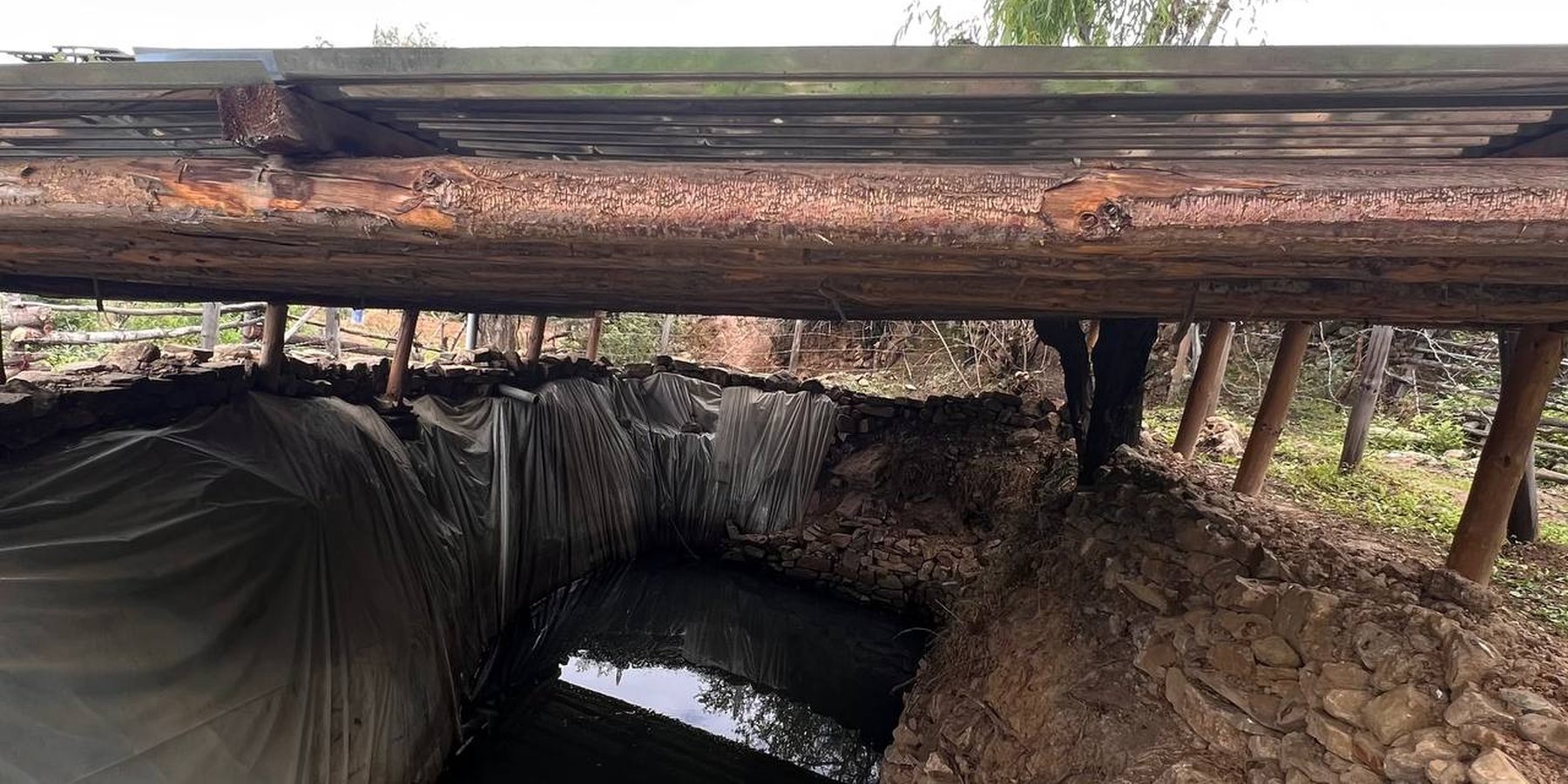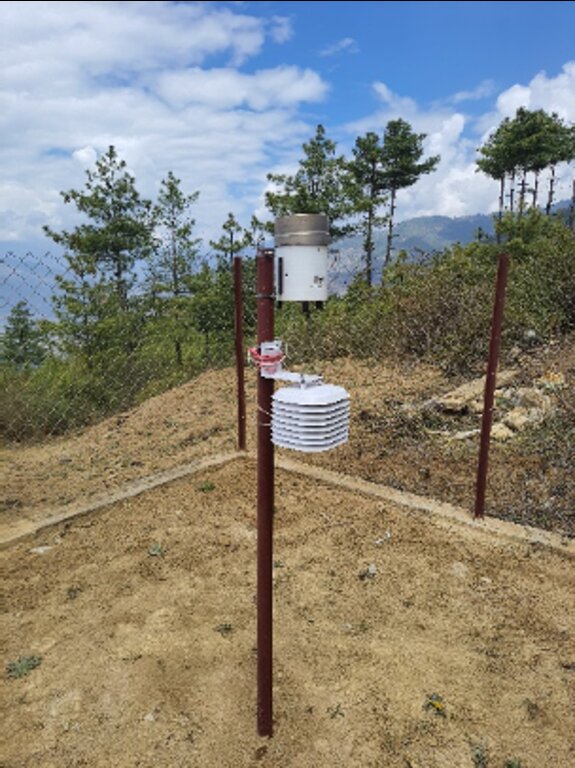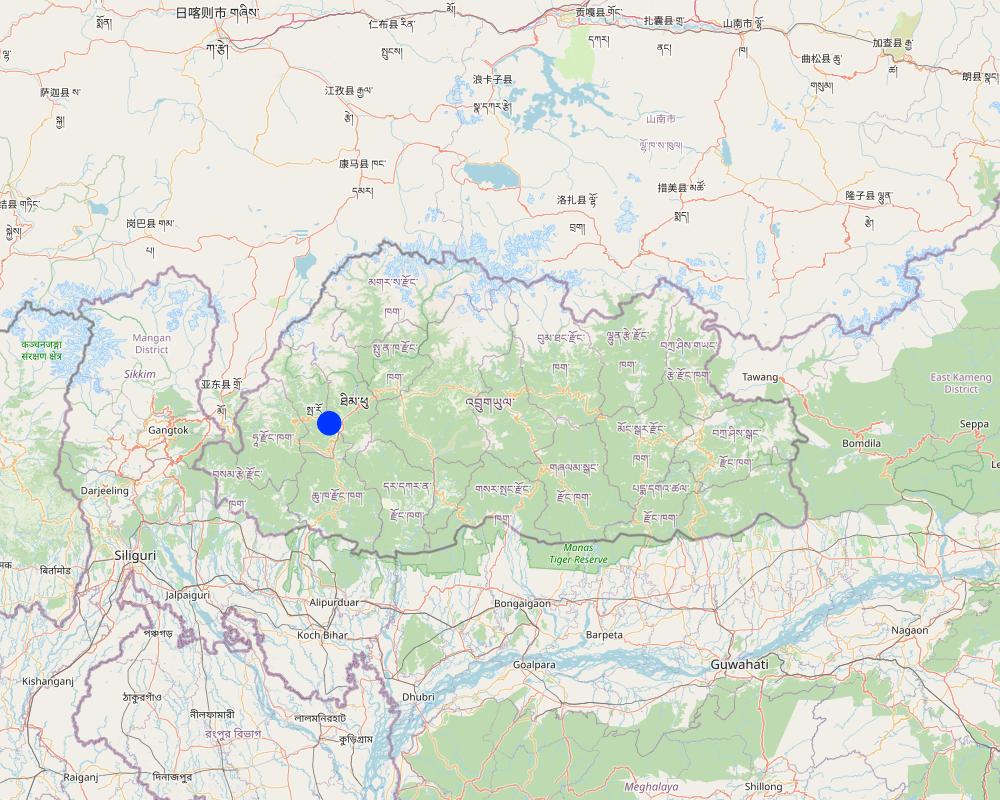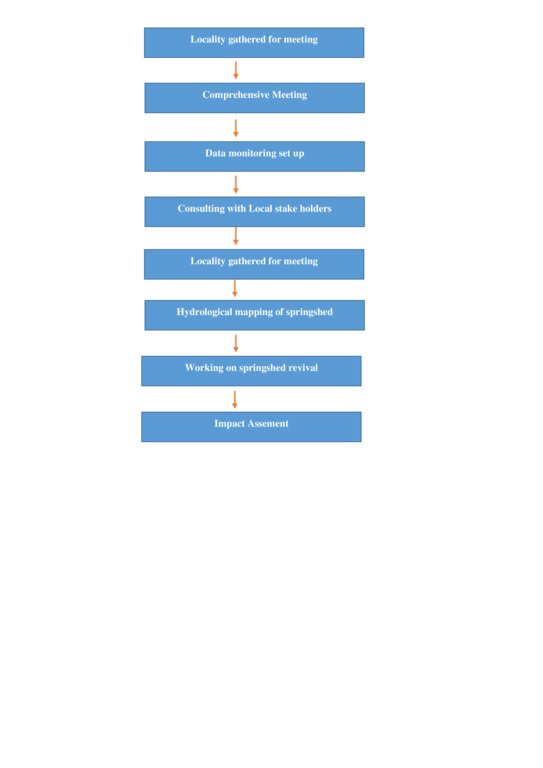Nature-based Solutions for Springshed Revival [Butão]
- Criação:
- Atualização:
- Compilador/a: Karma Wangdi
- Editor: Haka Drukpa
- Revisores: Rima Mekdaschi Studer, William Critchley
Rangzhin Thablam Thok Chhuka Sakhong Nyamsuung (རང་བཞིན་ཐབས་ལམ་ཐོག་ཆུ་རྐ་ས་ཁོངས་ཉམས་སྲུང་།)
approaches_6850 - Butão
Veja as seções
Expandir tudo Recolher tudo1. Informação geral
1.2 Detalhes do contato das pessoas capacitadas e instituições envolvidas na avaliação e documentação da abordagem
Pessoa(s) capacitada(s)
usuário de terra:
Dorji Gem
n/a
Lholing, Shaba Gewog (Block), Paro Dzongkhag (District)
Butão
usuário de terra:
Chencho Chencho
n/a
Lholing, Shaba Gewog (Block), Paro Dzongkhag (District)
Butão
usuário de terra:
Dorji Chencho
n/a
Lholing, Shaba Gewog (Block), Paro Dzongkhag (District)
Butão
usuário de terra:
Nidup Wangmo
n/a
Lholing, Shaba Gewog (Block), Paro Dzongkhag (District)
Butão
Nome do projeto que facilitou a documentação/avaliação da Abordagem (se relevante)
Strengthening national-level institutional and professional capacities of country Parties towards enhanced UNCCD monitoring and reporting – GEF 7 EA Umbrella II (GEF 7 UNCCD Enabling Activities_Umbrella II)Nome da(s) instituição(ões) que facilitou(ram) a documentação/avaliação da Abordagem (se relevante)
National Soil Services Center, Department of Agric (National Soil Services Center, Department of Agric) - Butão1.3 Condições em relação ao uso da informação documentada através de WOCAT
Quando os dados foram compilados (no campo)?
12/07/2023
O/a compilador/a e a(s) pessoa(s) capacitada(s) aceitam as condições relativas ao uso de dados documentados através da WOCAT:
Sim
2. Descrição da abordagem de GST
2.1 Descrição curta da abordagem
Springshed revival can be achieved through Nature-based Solutions (NbS) with a hydrogeological approach, complemented by socio-ecological inputs, and engineering surveys.
2.2 Descrição detalhada da abordagem
Descrição detalhada da abordagem:
Springs are natural occurrences where fresh water emerges from the ground through openings known as spring vents. They are outlets from aquifers, water-bearing layers underground, to the surface. The water in springs originates from rainfall during specific seasons, which falls on the springshed, infiltrates the ground and is collected as groundwater. When the groundwater is pressurized and rises, it creates springs, which then contribute to the flow of water into rivers or other water bodies. In mountainous regions like Bhutan, springs serve as the primary water source for rural households (ICIMOD, 2021).
Spring revival through “nature-based solutions” (NbS) in springsheds refers to a comprehensive effort aimed at reviving and restoring the functionality of springs. The primary objectives of spring revival initiatives include ensuring sustainable water supply, mitigating the threat of springs drying, conserving biodiversity, and improving the livelihoods of communities dependent on spring water. To achieve these goals, diverse methods are employed, involving various stakeholders. While spring revival offers numerous advantages, it also presents certain disadvantages that should be considered (Konek & Samanta, 2022).
The methods used under NbS to revive springs are multifaceted and typically involve a combination of hydrogeological, ecological, hydrological, and community-based approaches. Hydrogeology can lead to a better understanding of aquifers and the nature of springs and springsheds, thus providing ways for better management. Ecological methods focus on restoring the natural catchment area (the springshed itself) and improving vegetation cover to enhance water infiltration and recharge. Measures such as reforestation, contour trenching, and check dams are implemented to reduce erosion, promote groundwater recharge, and maintain spring flow. Hydrological interventions include the construction of recharge structures, groundwater recharge pits, and percolation tanks to replenish the aquifer and ensure sustained spring flow. Community-based approaches encompass raising awareness, capacity building, and participation in springshed conservation and management activities. These efforts often include the establishment of user groups, water committees, and the adoption of sustainable water use practices (Shrestha et al., 2017).
Stakeholders play vital roles in spring revival initiatives. Local communities living in Lholing areas are key stakeholders as they are directly affected by water availability and are actively involved in the preservation and management of springs. Government agencies such as the Department of Water, Department of Forests and Park Services and Gewog Administration provide technical expertise, funding, and policy support. Academic institutions and research organizations contribute scientific knowledge, monitoring, and evaluation, while international agencies and donor organizations may provide financial assistance and expertise.
According to Tamba et al. (2012) the advantages of spring revival are significant and far-reaching. By restoring spring flow, communities get access to a reliable and sustainable water source, which is crucial for their domestic, agricultural, and livestock needs. Spring revival through NbS also contributes to biodiversity conservation, as the presence of flowing water supports diverse aquatic and terrestrial ecosystems, including endemic species. Moreover, the revival of springs enhances groundwater recharge, which can benefit other water sources in the area. The community involvement and capacity-building aspects of NbS initiatives foster social cohesion, empowerment, and the development of local governance structures. Revived springs have the potential to enhance community resilience to climate change by providing water during periods of drought or erratic rainfall.
However, NbS also come with certain challenges and disadvantages. Adequate financial resources and long-term funding commitments are often required, which can pose a challenge in resource-constrained settings. Technical expertise and knowledge gaps may hinder the effectiveness of revival methods, emphasizing the need for capacity building and technical support. The involvement of multiple stakeholders can lead to coordination issues and conflicts of interest. Furthermore, the success of spring revival initiatives relies heavily on community participation. Thus, lack of community engagement or ownership can hinder sustainability. Environmental and social impacts need to be carefully considered, as inappropriate interventions or changes in hydrological patterns can have unintended consequences on ecosystems and communities (Khadka et al., 2019).
2.3 Fotos da abordagem
2.4 Vídeos da abordagem
Data:
12/07/2023
2.5 País/região/locais onde a abordagem foi aplicada
País:
Butão
Região/Estado/Província:
Shaba, Paro
Especificação adicional de localização:
Lholing Chiwog, Shaba Geog, Paro Dzongkhag
Map
×2.6 Datas de início e término da abordagem
Indique o ano de início:
2018
Caso o ano exato seja desconhecido, indique a data aproximada de início da abordagem:
menos de 10 anos atrás (recentemente)
2.7 Tipo de abordagem
- Baseado em projeto/programa
2.8 Principais metas/objetivos da abordagem
Nature-based solution to reviving springs as a source of water for:
1. Drinking
2. For animal use
3. Agriculture
2.9 Condição que propiciam ou inibem a implementação de tecnologia/tecnologias aplicada(s) segundo a abordagem
Normas e valores sociais/culturais/religiosos
- Propício
Water became the source of whole existence.
Disponibilidade/acesso a recursos e serviços financeiros
- Propício
This type of project can be brought into action with the help of continued implementation of activities and grants
Quadro institucional
- Propício
More stakeholders
Colaboração/coordenção de atores
- Propício
Quadro jurídico (posse de terra, direitos de uso da terra e da água)
- Propício
Water Act of Bhutan 2010
Políticas
- Propício
Drinking water has been a priority over other usage as per our Act and policies.
Governança da terra (tomada de decisões, implementação e aplicação)
- Propício
The Department of Water and Department of Forests and Park Services have been promoting conservation and management of water resources.
Conhecimento sobre GST, acesso a suporte técnico
- Inibitivo
Our farmers usually lacks the knowledge on SLM principle left without assisting in this type of field.
Mercados (para comprar entradas, vender produtos) e preços
- Propício
The communities have access to local markets to sell their agricultural products.
Carga de trabalho, disponibilidade de força de trabalho
- Inibitivo
Required huge labour contributions. Labour shortage is a problem
Outro
- Propício
3. Participação e papel das partes interessadas envolvidas
3.1 Partes interessadas envolvidas na abordagem e seus papéis
- Usuários de terra/comunidades locais
A total of 8 stakeholders were involved, only two of them are directly assisting in spring revival
Helped as a labor who have contributed in making trenches and fencing around the shed.
- Especialistas em GST/ consultor agrícola
8 Foresters from the Divisional Forest Office, Paro were involved
Planning, coordinating and providing technical assistance for the spring revival
- Governo local
Gup (Local Chief) and Tshogpa of Shaba Gewog Administration.
Administrative support
- Governo nacional (planejadores, responsáveis pelas decisões)
Department of Forests and Park Services
Provide technical support
- Organização internacional
Green Climate Fund, ICIMOD
Provide funding support and tecnnical expertise
3.2 Envolvimento do usuários de terra/comunidades locais nas diferentes fases da abordagem
| Envolvimento do usuários de terra/comunidades locais | Especifique quem estava envolvido e descreva as atividades | |
|---|---|---|
| Iniciação/motivação | Participativo | A person from each household was involved in the initial planning and meeting with the specialists to agree to. |
| Planejamento | Passivo | The plannings were mostly done by specialists from the forest department. |
| Implementação | Apoio externo | Land users/local community were engaged as paid labours. |
| Monitoramento/avaliação | Participativo | Twice a year monitoring is done by the specialists and other minor monitoring is dine by the community around the springsheds. |
| Nenhum | No research was carried out. |
3.3 Fluxograma (se disponível)
Descrição:
1. Comprehensive mapping of springs and springsheds.
2. Setting up of a data monitoring system.
3. Understanding socio-economic and governance systems of springs.
4. Hydrogeological mapping.
5. Creating a conceptual hydrogeological layout of the springshed.
6. Classification of spring type, identifying mountain aquifer and demarcating recharge area.
7. Developing springshed management and governance protocols and
8. Impact assessment.
Autor:
Singye Dorji & Tshering Gyeltshen
3.4 Decisão sobre a seleção de tecnologia/tecnologias de GST
Especifique quem decidiu sobre a seleção de tecnologia/tecnologias a serem implementadas:
- Principalmente especialistas em GST, após consulta com usuários da terra
4. Suporte técnico, reforço das capacidades e gestão do conhecimento
4.1 Reforço das capacidades/ formação
Foi oferecida formação aos usuários da terra/outras partes interessadas?
Não
4.2 Serviço de consultoria
Os usuários de terra têm acesso a um serviço de consultoria?
Sim
Especifique se foi oferecido serviço de consultoria:
- nas áreas dos usuários da terra
4.3 Fortalecimento da instituição (desenvolvimento organizacional)
As instituições foram fortalecidas ou estabelecidas através da abordagem?
- Sim, pouco
Especifique a que nível (níveis) as instituições foram fortalecidas ou estabelecidas:
- Local
4.4 Monitoramento e avaliação
Monitoramento e avaliação são partes da abordagem?
Sim
Comentários:
Physical on site monitoring and evaluating the springshed
Caso afirmativo, esta documentação é destinada a ser utilizada para monitoramento e avaliação?
Não
4.5 Pesquisa
A pesquisa foi parte da abordagem?
Não
5. Financiamento e apoio material externo
5.1 Orçamento anual para o componente de GST da abordagem
Caso o orçamento exato seja desconhecido, indique a faixa:
- < 2.000
Comentários (p. ex. principais fontes de recursos/principais doadores):
Royal Government of Bhutan funding was released under Ministry of Energy and Natural Resources (erstwhile Ministry of Agriculture and Forests).
5.2 Apoio financeiro/material concedido aos usuários da terra
Os usuários da terra receberam apoio financeiro/material para a implementação de tecnologia/tecnologias?
Sim
Caso afirmativo, especifique tipo(s) de apoio, condições e fornecedor(es):
The government fully funded the initiative of springshed revival where they even paid N. 700 to the labour helpers that from the community engaged.
5.3 Subsídios para entradas específicas (incluindo mão-de-obra)
- Mão-de-obra
| Em que medida | Especifique os subsídios |
|---|---|
| Totalmente financiado | Paid for the local labourers and also 4 technicals staffs from Department of Forest and Park Services. |
- Equipamento
| Especifique quais entradas foram subsidiadas | Em que medida | Especifique os subsídios |
|---|---|---|
| Maquinário | Totalmente financiado | One Excavator untill the completion of the project. |
| Ferramentas | Totalmente financiado | Basic tools such as spades, crowbars and shovel. |
| Totalmente financiado | Lunch and refreshments for all the labourers. | |
- Construção
| Especifique quais entradas foram subsidiadas | Em que medida | Especifique os subsídios |
|---|---|---|
| Barbed Wire Fence. | Totalmente financiado | For a few bigger springsheds. |
Se a mão-de-obra pelos usuários da terra foi uma entrada substancial, isso foi:
- Pago em dinheiro
Comentários:
The labour by land users were paid Nu. 700 per day with free lunch and refreshments.
5.4 Crédito
Foi concedido crédito segundo a abordagem para atividades de GST?
Não
5.5 Outros incentivos ou instrumentos
Foram utilizados outros incentivos ou instrumentos para promover a implementação das tecnologias de GST?
Não
6. Análise de impactos e declarações finais
6.1 Impactos da abordagem
A abordagem concedeu autonomia aos usuários locais de terra, melhorou a participação das partes interessadas?
- Não
- Sim, pouco
- Sim, moderadamente
- Sim, significativamente
The approach helped local land users understand about some basic Knowledges in springshed management and maintenance.
A abordagem propiciou a tomada de decisão baseada em evidências?
- Não
- Sim, pouco
- Sim, moderadamente
- Sim, significativamente
Yes the decisions made were always discussed and consulted together.
A abordagem auxiliou os usuários da terra a implementar e manter as tecnologias de GST?
- Não
- Sim, pouco
- Sim, moderadamente
- Sim, significativamente
The approach lead to the implementation of important SLM Technologies which involved water storage, check dams and benchmark preparations
A abordagem aprimorou o conhecimento e as capacidades dos usuários da terra para implementar a GST?
- Não
- Sim, pouco
- Sim, moderadamente
- Sim, significativamente
Yes in this springshed revival (nature-based solution)
A abordagem aprimorou o conhecimento e as capacidades de outras partes interessadas?
- Não
- Sim, pouco
- Sim, moderadamente
- Sim, significativamente
Yes this approach lead to the improvement of knowledge about ground water and springs.
A abordagem construiu/fortaleceu instituições, colaboração entre partes interessadas?
- Não
- Sim, pouco
- Sim, moderadamente
- Sim, significativamente
Yes, it helped/enhanced the cooperation and systematic use of the spring water for various uses for washing and cattle feeding.
A abordagem atenuou conflitos?
- Não
- Sim, pouco
- Sim, moderadamente
- Sim, significativamente
In the past people had recurring conflicts with regard to use and division of the small water source. After this approach with the implementation of systematic use of water from the springshed conflicts among land users are greatly reduced.
A abordagem encorajou os jovens/as próximas gerações de usuários de terra a se envolverem na GST?
- Não
- Sim, pouco
- Sim, moderadamente
- Sim, significativamente
The springshed revival of Lholing encouraged few young people to stay back at home with their parents to work in the farms, now that they are able to get some amount of irrigation water from the springsheds that are revived.
A abordagem resultou em segurança alimentar aprimorada/nutrição melhorada?
- Não
- Sim, pouco
- Sim, moderadamente
- Sim, significativamente
The approach of springshed revival helped improve food security to some extent as the approach encouraged the land users to establish kitchen gardens where irrigation was done from the spring water that were revived and created.
A abordagem resultou em acesso melhorado à água e ao saneamento?
- Não
- Sim, pouco
- Sim, moderadamente
- Sim, significativamente
It definitely improved sanitation as they used spring water for bathing and laundry purposes.
A abordagem resultou em emprego, oportunidades de renda?
- Não
- Sim, pouco
- Sim, moderadamente
- Sim, significativamente
Yes a little through farming activities.
6.2 Principal motivação dos usuários da terra para implementar a GST
- Produção aumentada
In case of farm products.
- Lucro (lucrabilidade) aumentado, melhora da relação custo-benefício
- Consciência ambiental
The springsheds not only provides drinking water fir the domestic animals but for some of wild animals such as deer.
- melhoria dos conhecimentos e aptidões de GST
Local land users understood the importance of SLM and springshed maintenance.
- Atenuação de conflitos
The different spring sheds offered various sources of spring water reducing conflict related to equal use of irrigation for the paddy.
6.3 Atividades de sustentabilidade de abordagem
Os usuários da terra podem manter o que foi implementado através da abordagem (sem apoio externo)?
- Sim
Caso afirmativo, descreva como:
Now that the springsheds are revived, the local land users with some basic knowledge could do necessary maintenance and protection of these vital area.
6.4 Pontos fortes/vantagens da abordagem
| Pontos fortes/vantagens/oportunidades na visão do usuário da terra |
|---|
| Provides a source of drinking water for wild animals. |
| Provides drinking water source for the domestic animals |
| Improved sanitation through constant supply of spring water. |
| Pontos fortes/vantagens/oportunidades na visão do/a compilador/a ou de outra pessoa capacitada |
|---|
| Increased source of irrigation water from different spring-shed. |
| Balanced ecological management of water resources. |
| Catchment area created as springshed could prevent splash and rill erosions. |
6.5 Pontos fracos, desvantagens da tecnologia e formas de superá-los
| Pontos fracos/desvantagens/riscos na visão do usuário da terra | Como eles podem ser superados? |
|---|---|
| Attracts wild animals to the nearby field which come to drink water from the springsheds. | Improved fencing of the fields |
| Pontos fracos/vantagens/riscos na visão do/a compilador/a ou de outra pessoa capacitada | Como eles podem ser superados? |
|---|---|
| Artificial creating of some of springshed lead to loss of pasture lands | |
| Risk of cattle/ children drowning in the bigger spring-sheds | Fencing around the springshed. |
7. Referências e links
7.1 Métodos/fontes de informação
- visitas de campo, pesquisas de campo
There were three numbers of informants. The Ranger and agriculture extension supervisor of Shaba Geog and a progressive farmer from Lholing.
7.2 Referências às publicações disponíveis
Título, autor, ano, ISBN:
ICIMOD. (2021). Springshed revival and management Implement gender-responsive interventions around spring revival and management in the HKH and influence policy uptake
Disponível de onde? Custos?
Websites (Free)
Título, autor, ano, ISBN:
Tambe et al. (2012). Reviving Dying Springs: Climate Change Adaptation Experiments From the Sikkim Himalaya.
Disponível de onde? Custos?
Google Scholar
Título, autor, ano, ISBN:
Shrestha et al. (2017). Application of Eight-step Methodology for Reviving Springs and Improving Springshed Management in the Mid-hills of Nepal.
Disponível de onde? Custos?
Google Scholar
Título, autor, ano, ISBN:
Khadka et al. (2019). Integrated River System Resource Management Planning: A Stepping Stone for Sustainable Conservation of Chure-TaraiMadhesh Landscape
Disponível de onde? Custos?
Google Scholar
Título, autor, ano, ISBN:
Koner, K. & Samanta, G. (2022). Reviving traditional water sources for resilient water future: case of Darjeeling City, India.
Disponível de onde? Custos?
Springer
7.3 Links para informação relevante que está disponível online
Título/ descrição:
Springshed revival and management Implement gender-responsive interventions around spring revival and management in the HKH and influence policy uptake.
URL:
https://www.icimod.org/initiative/rms/springshed-revival-and-management/
Título/ descrição:
Reviving Dying Springs: Climate Change Adaptation Experiments From the Sikkim Himalaya.
URL:
https://doi.org/10.1659/MRD-JOURNAL-D-11-00079.1
Título/ descrição:
Application of Eight-step Methodology for Reviving Springs and Improving Springshed Management in the Mid-hills of Nepal.
URL:
https://cgspace.cgiar.org/handle/10568/90596
Título/ descrição:
Integrated River System Resource Management Planning: A Stepping Stone for Sustainable Conservation of Chure-TaraiMadhesh Landscape
URL:
https://nast.gov.np/documentfile/Proceedings.pdf#page=18
Título/ descrição:
Reviving traditional water sources for resilient water future: case of Darjeeling City, India.
URL:
https://link.springer.com/article/10.1007/s10708-021-10444-z
Links e módulos
Expandir tudo Recolher tudoLinks
Não há links
Módulos
Não há módulos







